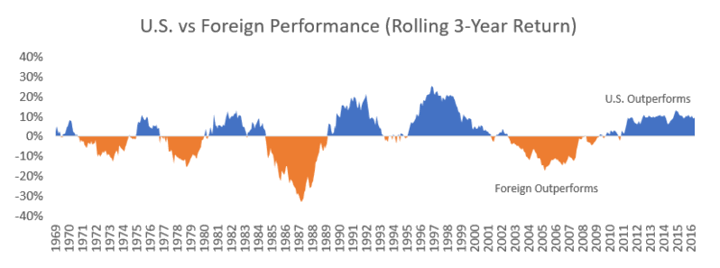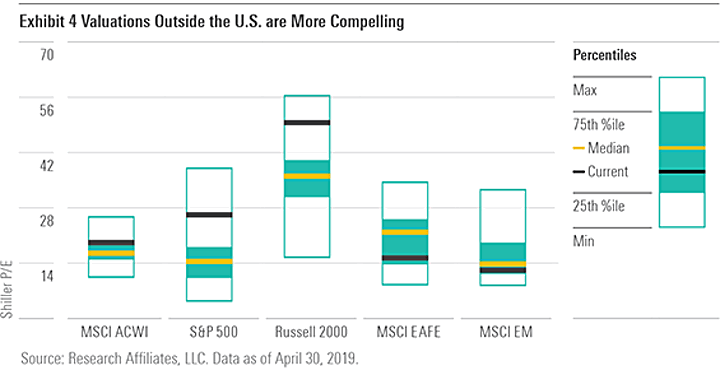One the big decisions in portfolio construction is how much to allocate between US stocks and non-US stocks. You won’t find universal agreement on a correct answer, but this Morningstar article Investors Have Fewer Reasons Than Ever for Home Bias by Ben Johnson does a nice job of outlining the factors behind “home bias”:
“Home bias” is the term used to describe investors’ tendency to tilt their portfolios in favor of domestic stocks (bonds, too, but I’m going to focus on stocks). Here, I’ll discuss how home bias is measured, the factors that underpin this phenomenon, and why it’s probably a good idea to expand your horizons a bit.
Sometimes the US outperforms international stocks for a while. Sometimes it lags. Here is a chart from Factor Investor that helps you visualize these past cycles:

Right now, the market cap of the world’s publicly-traded businesses split at roughly 55% US and 45% international. This ratio has been flipped in the past (45% US/55% International) but the US has performed much better in the past decade.
Right now, the US looks great but International stocks have much higher earnings yields. The most interesting chart from the Morningstar article shows the current Shiller P/E Ratio amid the range of historical valuations for major indexes including the S&P 500, MSCI EAFA (Developed International), and MSCI EM (Emerging Markets). You can see that US stocks are currently on the high (expensive) side, while the international stocks are on the low (cheap) side.

It’s a tug of war. US stocks have done better recently. US stocks have a rosier outlook, which results in them being more expensive. International stocks have a bleaker outlook, but the price-to-earning ratios are much cheaper. If you own a Vanguard Target Retirement 20XX Fund or a LifeCycle Fund, you own 60% US/40% International. Most of the other Target Date Funds break it down differently, so you’ll have to check. I am in the market-weight camp and hold either 50/50 for simplicity. I have seen opinions of what is “best” change over time, and that supports the advice of having a written investment policy statement of what you believe and why.

 The Best Credit Card Bonus Offers – 2025
The Best Credit Card Bonus Offers – 2025 Big List of Free Stocks from Brokerage Apps
Big List of Free Stocks from Brokerage Apps Best Interest Rates on Cash - 2025
Best Interest Rates on Cash - 2025 Free Credit Scores x 3 + Free Credit Monitoring
Free Credit Scores x 3 + Free Credit Monitoring Best No Fee 0% APR Balance Transfer Offers
Best No Fee 0% APR Balance Transfer Offers Little-Known Cellular Data Plans That Can Save Big Money
Little-Known Cellular Data Plans That Can Save Big Money How To Haggle Your Cable or Direct TV Bill
How To Haggle Your Cable or Direct TV Bill Big List of Free Consumer Data Reports (Credit, Rent, Work)
Big List of Free Consumer Data Reports (Credit, Rent, Work)
I’m a little unclear with the P/E of the russell 2000. Do you have a source where this info lives? When I check the P/E of small/mids, it’s no way near that median or current… I must be missing something.
Ah but I think I get it now: “When the price-earnings ratio is calculated, also negative earnings have been taken account. This makes the ratio much higher than the trailing P/E reported by e.g. FTSE Russell which excludes companies reporting negative net income.”